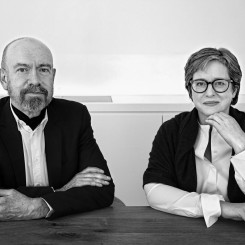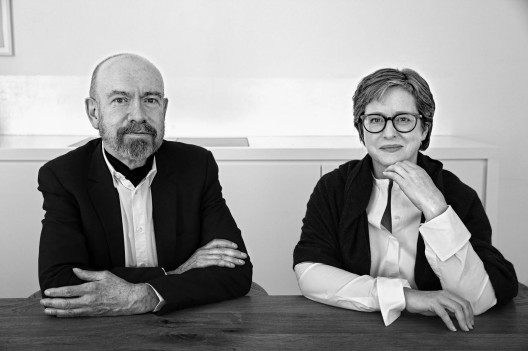An art dealer is married to their collectors, whilst a gallerist is married to their artists. Of course, this is an over-simplification: not all marriages are happy. The distinction, though, reflects one of the key criteria for participation in Art Basel: the development—not merely the promotion—of an artist’s career. In this regard, a “program gallery” is a special subcategory, one usually marked by an intellectual aesthetic. Often, its artists will be close colleagues. Its exhibition schedule is a carefully planned “program”, quite frequently one eschewing immediate commercial gain. Which is to say, the artist comes first. Examples include Gavin Brown Enterprises, Marian Goodman in New York, Lisson Gallery and Sadie Coles HQ in London. It is in Berlin, however, that program galleries have emerged as preeminently influential.
Leading Berlin gallerists Esther Schipper and Jörg Johnen recently announced an acquisition-merger, with Schipper taking a majority interest in Johnen Galerie GmbH, potentially creating one of the most impressive stables of artists in Europe. Of the two, only Johnen Galerie has any Asian artists as yet (Liu Ye and Yoshitomo Nara). Nonetheless, the merger has potential consequences for China. Artists, galleries and collectors in China should and are paying attention, because the dedicated cultivation of relationships and a specific aesthetic and representing a certain generation of artists clearly resonates with the approach of the most successful galleries in China (such as Beijing Commune’s almost symbiotic relationship with Pace)—more so, perhaps, than the relatively ostentatious strategies of certain (dealer) counterparts in London and New York.
25 years ago, save for Japanese collectors of French Impressionism, the art market was predominantly a Western preserve. Now it is much bigger and more international, but it is still very small compared with almost any other market. As art remains a matter of subjective opinion and access, whether to collectors or artworks, the art market is ruled by personal connections. In this opaque, unregulated world, the key question is “Who?” With a tradition of collecting thousands of years old, China is particularly attuned to this situation, especially given its ambition (the German term “Ehrgeiz” is subtler, conveying, as well as pride and desire, a sense of determination and self-confidence). Following German reunification in 1989, cheap real estate and an interesting character led to Berlin becoming a major art production center, and the galleries followed (often as not from Cologne), even though Berlin itself was a financial mess (and still is).
The art gallery “system” (if that word is not too strong) revolves around a handful of hubs, each of which has developed a more or less distinctive character. The art market was invented in Paris and perfected in New York, but Basel, Berlin, London and Los Angeles also have their own particular approaches. And over the past 20 years—particularly the last 5—each has developed, by accident and design, networks with China’s art centers in Beijing, Shanghai and Hong Kong. While art’s financial cynosure remains New York, one of the most successful approaches in developing gallery networks is what may be called the “Basel-Berlin” approach. In part, it reflects the current economic ascendancy of the German-speaking economy in Europe. But it also has a lot to do with the way Berlin galleries have strategically courted Art Basel over many years, becoming deeply integrated with its structures — not least on the selection committee. And this strategic, subtle approach is also reflect in the dedicated development of relations with Chinese artists, collectors and leading “program” galleries such as Beijing Commune, Galleria Continua, Galerie Urs Meile, Long March Space, ShanghART, Tang Contemporary and Vitamin Creative Space, as well as Singapore Tyler Print Institute.
The principal examples of such Swiss, German and Austrian galleries include (alphabetically—we don’t want to cause unnecessary upset) CFA, Esther Schipper, Galerie Eva Presenhuber, Galerie Krinzinger, Galerie Nächst St. Stephan, Galerie Neu, Eigen+Art, König Galerie, neugerriemschneider, Nordenhake and Sprüth Magers. Of these, a small group including neugerriemschneider, Eigen+Art and now Esther Schipper has quietly developed particularly strong networks in China through co-operations with key local galleries and agents and astutely courting influential collectors. Austrian Thaddaeus Ropac, Germans David Zwirner and Michael Werner, and Swiss Hauser & Wirth (tied primarily to Paris, New York and London, respectively), fall into different, albeit related, categories. Traffic is not all one-way. ShanghART, Galerie Urs Meile, Vitamin Creative Space and Beijing Commune have all developed strong relationships with key Western Galleries, notably Hauser & Wirth, neugerriemschneider and Pace Gallery. Also important to mention is Alexander Ochs, whose gallery in Beijing and Berlin was one of the seminal players in developing the Chinese art market in Germany.
Johnen Galerie has participated in Art Basel Hong Kong since 2013. While Esther Schipper only joined ABHK this year, the gallery has a Berlin-based director, Shi-ne Oh, from Seoul and a permanent representative in China. Most importantly, however, the artists whom the merged gallery represents are equally influential in China and in the West, including—from Schipper—Angela Bulloch, Pierre Huyghe, Dominique Gonzalez-Foerster, Liam Gillick, Philippe Parreno, and Ugo Rondinone; and from Johnen, Martin Boyce, David Claerbout, Martin Creed, Ryan Gander, Roman Ondák, Thomas Ruff and Tino Sehgal.
Schipper, who once worked for Monika Sprüth in Cologne, has overseen rapid growth in recent years, as many of the artists she has long represented such as Huyghe, Parreno and Gonzalez-Foerster have become some of the most influential artists of their generation.
Jörg Johnen was for a long time an art writer and curator. In 1984, Johnen opened his gallery in Cologne to represent the artists in whom he believed, such as Stephane Balkenhol, and to show their work in a precise and thoughtfully curated manner. It was this same sensibility that led him to regularly visit Esther Schipper’s gallery after it opened in 1990. Now 65, Johnen confesses that the new international world of constant art fairs is not to his taste. At the same time, he wishes to ensure the ongoing representation of his artists. Given the similarities of these two program galleries, the opportunity to merge was almost organic. Having eschewed the multi-city strategy of some bigger galleries, after decades of dedicated work, Esther Schipper is now, one of the most important galleries in Europe and internationally. And all of a sudden, Berlin is not so far from Beijing.




